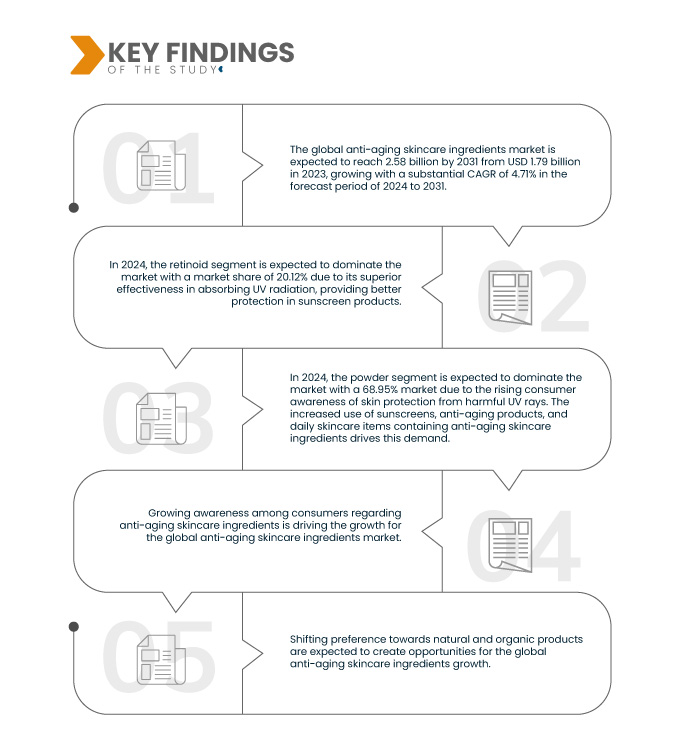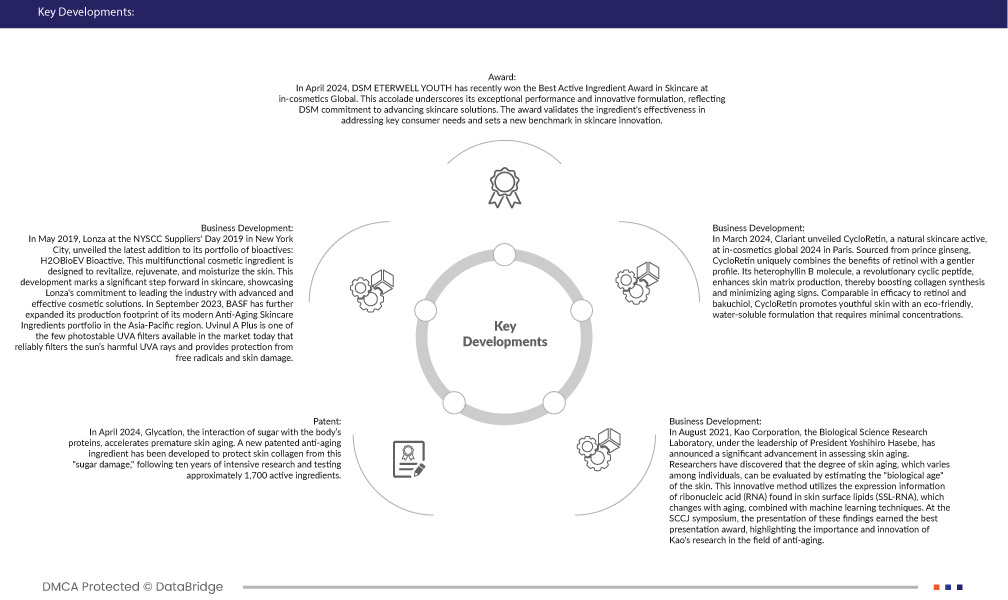Anti-aging skincare ingredients are active compounds used in cosmetic and dermatological products designed to reduce or prevent the visible signs of aging, such as wrinkles, fine lines, and age spots. These ingredients, including retinoid, peptides, antioxidants, hyaluronic acid, and botanical extracts, work by boosting collagen production, improving skin elasticity, and protecting against environmental damage. They are commonly found in creams, serums, and other topical applications. The effectiveness of these ingredients varies, with some offering scientifically proven benefits, while others provide more subjective or cosmetic improvements to the skin's appearance.
Access Full Report @ https://www.databridgemarketresearch.com/fr/reports/global-anti-aging-skincare-ingredients-market
Data Bridge Market Research analyzes that the Global Anti-Aging Skincare Ingredients Market is expected to reach 2.58 billion by 2031 from USD 1.79 billion in 2023, growing with a substantial CAGR of 4.71% in the forecast period of 2024 to 2031.
Key Findings of the Study
- Rise In Disposable Income And Increase In Urban Population
As disposable incomes rise, consumers have more financial flexibility to spend on discretionary items, including beauty and personal care products. This increased spending power is not just confined to luxury goods but extends to a broader range of beauty products and services. Consumers are now willing to invest in high-quality, premium, and innovative beauty products that were previously considered out of reach.
Moreover, rising disposable income is also driving demand for personalized and specialized beauty products. Consumers are increasingly looking for products tailored to their specific needs, whether it’s anti-aging solutions, skin hydration, or color cosmetics. This trend is pushing brands to innovate and offer a diverse range of products
Report Scope and Market Segmentation
|
Report Metric
|
Details
|
|
Forecast Period
|
2024 to 2031
|
|
Base Year
|
2023
|
|
Historic Years
|
2022 (Customizable to 2016-2021)
|
|
Quantitative Units
|
Revenue in USD Billion
|
|
Segments Covered
|
Product (Retinoid, Hyaluronic Acid, Antioxidants, Peptides, Niacinamide (Vitamin B3), Alpha Hydroxy Acids (AHAS), Ceramides, Zinc Oxide & Titanium Dioxide, Beta Hydroxy Acid (BHA), Coenzyme Q10 (Ubiquinone), Green Tea Extract, Alpha Lipoic Acid, Caffeine, Bakuchiol, Squalane, Kojic Acid, Alpha-Arbutin, Soy Isoflavones and Others), Form (Powder, Liquid, and Granular), Function (Moisturizing, Collagen Boosting, Sun Protection, Exfoliation, Skin Brightening, Anti-Inflammatory, Skin Repair, and Others) Application (Anti-Wrinkle, Anti-Pigmentation, Anti-Oxidation, Dermal Fillers, and Others), End Use (Serum, Moisturizer, Cleanser, Eye Cream, Face Oil, Mask, Toner, and Others)
|
|
Countries Covered
|
U.S., Canada, Mexico, China, Japan, South Korea, India, Australia & New Zealand, Indonesia, Thailand, Malaysia, Philippines, Singapore, rest of Asia-Pacific, Germany, France, U.K., Italy, Russia, Spain, Netherlands, Belgium, Switzerland, Turkey, rest of Europe, Brazil, Argentina, rest of South America, United Arab Emirates, Saudi Arabia, South Africa, Egypt, Israel, and rest of Middle East and Africa
|
|
Market Players Covered
|
ADEKA CORPORATION (Japan), Beiersdorf AG (Germany), Croda International Plc (U.K.), BASF SE (Germany), Wacker Chemie AG (Germany), Lonza (Switzerland), CLARIANT (Switzerland), Evonik Industries AG (Germany), DSM (Netherlands), Kao Corporation (Japan), BioThrive Sciences (U.S.), and Contipro a.s (Czech Republic) among others
|
|
Data Points Covered in the Report
|
In addition to the insights on market scenarios such as market value, growth rate, segmentation, geographical coverage, and major players, the market reports curated by the Data Bridge Market Research also include in-depth expert analysis, pricing analysis, brand share analysis, consumer survey, demography analysis, supply chain analysis, value chain analysis, raw material/consumables overview, vendor selection criteria, PESTLE Analysis, Porter Analysis, and regulatory framework.
|
Segment Analysis
The global anti-aging skincare ingredients market is segmented into five notable segments based on product, form, function, application, and end use.
- On the basis of product, the global anti-aging skincare ingredients market is segmented into hyaluronic acid, antioxidants, peptides, niacinamide (vitamin b3), Alpha Hydroxy Acids (AHAs), ceramides, zinc oxide & titanium dioxide, Beta Hydroxy Acid (BHA), coenzyme Q10 (ubiquinone), green tea extract, alpha lipoic acid, caffeine, bakuchiol, squalane, kojic acid, alpha-arbutin, soy isoflavones and others
In 2024, the retinoid segment is expected to dominate the global anti-aging skincare ingredients market
In 2024, the retinoid segment is expected to dominate the market with a market share of 20.12% due to its superior effectiveness in absorbing UV radiation, providing better protection in sunscreen products.
- On the basis of form, the global anti-aging skincare ingredients market is segmented into powder, liquid, and granular
In 2024, the powder segment is expected to dominate the global anti-aging skincare ingredients market
In 2024, the powder segment is expected to dominate the market with a 68.95% market due to the rising consumer awareness of skin protection from harmful UV rays. The increased use of sunscreens, anti-aging products, and daily skincare items containing anti-aging skincare ingredients drives this demand.
- On the basis of function, the global anti-aging skincare ingredients market is segmented into moisturizing, collagen boosting, sun protection, exfoliation, skin brightening, anti-inflammatory, skin repair, and others. In 2024, the moisturizing segment is expected to dominate the market with a market share of 29.79%
- On the basis of application, the global anti-aging skincare ingredients market is segmented into anti-wrinkle, anti-pigmentation, anti-oxidation, dermal fillers, and others. In 2024, the anti-wrinkle segment is expected to dominate the market with a market share of 37.20%
- On the basis of end use, the global anti-aging skincare ingredients market is segmented into serum, moisturizer, cleanser, eye cream, face oil, mask, toner, and others. In 2024, serum segment is expected to dominate the market with a market share of 31.89%
Major Players
Data Bridge Market Research analyzes Croda International Plc (U.K.), BASF SE (Germany), CLARIANT (Switzerland), Evonik Industries AG (Germany), Kao Corporation (Japan) as the major players in the global anti-aging skincare ingredients market.
Market Developments
- In April 2024, DSM ETERWELL YOUTH has recently won the Best Active Ingredient Award in Skincare at in-cosmetics Global. This accolade underscores its exceptional performance and innovative formulation, reflecting DSM commitment to advancing skincare solutions. The award validates the ingredient's effectiveness in addressing key consumer needs and sets a new benchmark in skincare innovation
- In May 2019, Lonza at the NYSCC Suppliers' Day 2019 in New York City, unveiled the latest addition to its portfolio of bioactives: H2OBioEV Bioactive. This multifunctional cosmetic ingredient is designed to revitalize, rejuvenate, and moisturize the skin. This development marks a significant step forward in skincare, showcasing Lonza's commitment to leading the industry with advanced and effective cosmetic solutions
- In September 2023, BASF has further expanded its production footprint of its modern anti-aging skincare ingredients portfolio in the Asia-Pacific region. Uvinul A Plus is one of the few photostable UVA filters available in the market today that reliably filters the sun’s harmful UVA rays and provides protection from free radicals and skin damage
- In April 2024, Glycation, the interaction of sugar with the body’s proteins, accelerates premature skin aging. A new patented anti-aging ingredient has been developed to protect skin collagen from this "sugar damage," following ten years of intensive research and testing approximately 1,700 active ingredients
- In August 2021, Kao Corporation, the Biological Science Research Laboratory, under the leadership of President Yoshihiro Hasebe, has announced a significant advancement in assessing skin aging. Researchers have discovered that the degree of skin aging, which varies among individuals, can be evaluated by estimating the "biological age" of the skin. This innovative method utilizes the expression information of ribonucleic acid (RNA) found in skin surface lipids (SSL-RNA), which changes with aging, combined with machine learning techniques. At the SCCJ symposium, the presentation of these findings earned the best presentation award, highlighting the importance and innovation of Kao's research in the field of anti-aging
- In March 2024, Clariant unveiled CycloRetin, a natural skincare active, at in-cosmetics Global 2024 in Paris. Sourced from prince ginseng, CycloRetin uniquely combines the benefits of retinol with a gentler profile. Its heterophyllin B molecule, a revolutionary cyclic peptide, enhances skin matrix production, thereby boosting collagen synthesis and minimizing aging signs. Comparable in efficacy to retinol and bakuchiol, CycloRetin promotes youthful skin with an eco-friendly, water-soluble formulation that requires minimal concentrations
Regional Analysis
Geographically, the countries covered in the global anti-aging skincare ingredients market report are U.S., Canada, Mexico, China, Japan, South Korea, India, Australia & New Zealand, Indonesia, Thailand, Malaysia, Philippines, Singapore, rest of Asia-Pacific, Germany, France, U.K., Italy, Russia, Spain, Netherlands, Belgium, Switzerland, Turkey, rest of Europe, Brazil, Argentina, rest of South America, United Arab Emirates, Saudi Arabia, South Africa, Egypt, Israel, and rest of Middle East and Africa.
As per Data Bridge Market Research analysis:
Asia-Pacific is the dominant and fastest growing region in the global anti-aging skincare ingredients market
Asia-Pacific is expected to dominate the market due to its large and growing population, increasing awareness about skin protection, and rising disposable incomes drives demand for Anti-Aging Skincare Ingredients in sunscreen and skincare products.
Asia-Pacific is estimated to be the fastest-growing region in the global Anti-Aging Skincare Ingredients market
Asia-Pacific is expected to grow during the forecast period 2024 to 2031 as the region's booming cosmetics and personal care industry.
For more detailed information about the Global Anti-Aging Skincare Ingredients Market report, click here – https://www.databridgemarketresearch.com/fr/reports/global-anti-aging-skincare-ingredients-market














